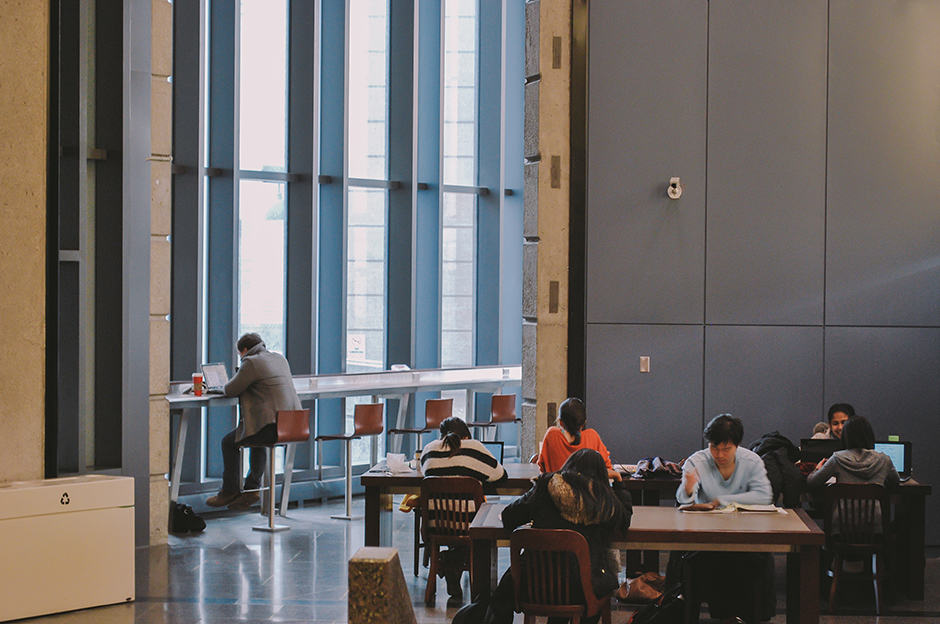The average adult is advised to get at least eight hours of sleep.
Yusheny Qiu, a fourth-year mineral engineering student, is not far off that mark, saying that, on average, he gets about six hours of sleep a night.
While most students wander off to the land of nod in the comfort of their own beds, Qiu, who commutes from Etobicoke, says he often catches up on sleep at the Student Rock Lounge in the Lassonde Mineral Engineering Building, and then showers at the Athletic Centre — sometimes staying at the University of Toronto from Monday to Friday without going home.
Qiu’s story is not uncommon at U of T.
For Tosin Adeyinka, a fourth-year geology and health and disease student, Robarts Library is more than a place to study. “I camp here… yesterday I came at 2:00 pm and stayed here until 7:00 am. I came back at 3:00 pm today, and am planning to do the same thing,” Adeyinka says.
All-day, all-night
Clayton Domina, a second-year commerce student, says that he does most of his studying at night because he finds it easier to concentrate when it’s late and there are fewer distractions.
According to Lari Langford, head of access and information at Robarts Library, the library formally introduced extended hours in 2004 after a two-year pilot project.
Langford explains that the change was triggered by a number of students expressing interest in 24-hour study spaces on campus.
Some students have taken the convenience of extended hours a step further, turning the university library into their temporary home.
The trend of students living at the library came to light in 2004, when Steve Stanzak, “The Bobst Boy” gained notoriety for living in New York University’s Bobst Library for eight months to save on accommodation costs.
University solutions
What prompts students to take such drastic measures?
For Qiu — who keeps his toothbrush, toothpaste, and other essentials on campus — his heavy work load and commute influence his decision to stay on campus.
“It’s not a big deal for me to not go home,” he says.
Whether the result of long commutes or heavy workload, some universities are taking note of the fact that students spend an increasing amount of time at libraries during the night.
Last April, the University of Michigan introduced napping stations in the Shapiro Undergraduate Library.
The library, which is open 24 hours a day, 7 days a week, now provides students with vinyl cots, allowing those in need of a break to take a quick nap during their study session.
The university wants students to realize that they do not have to sacrifice sleep to complete their work.
James Madison University in Harrisonburg, Virginia, offers similar services to students with the “NapNook,” a room in the student centre where students can take 40-minute naps on beanbags and antimicrobial pillows.
The University of Perth, in Australia, has gone a step further, bringing in “Metronaps EnergyPods” that allow students to take a 20-minute nap to re-energize.
The Pods, which play soothing music and gently vibrate, give students the energy boost they need to carry on working.
Although the U of T libraries have yet to implement such services, some students and library staff are open to changes that would nurture a more supportive environment for overnight library sessions.
When asked whether U of T should adopt napping stations in study spaces, Bukky Aina, a fourth-year psychology and ecology and evolutionary biology student, expressed enthusiasm. “We don’t need dogs, we need that,” Aina says, referencing the therapy dogs that are sometimes available to students during exams.
Robarts revitalization
Langford says that Robarts Library will soon enter phase two of a multi-year set of construction projects. The project has already received funding.
Although NapNooks, EnergyPods, and other napping facilities are not explicitly part of the plan, Langford says that the new section of the library will include “state of the art” study spaces.
When the revitalization is complete, the floors of Robarts Library that are currently open 24 hours will close at normal operating hours, and phase two spaces will remain open all night.
Meanwhile, students preparing for midterm exams will continue to be found working, sleeping, and brushing their teeth in U of T study spaces.


